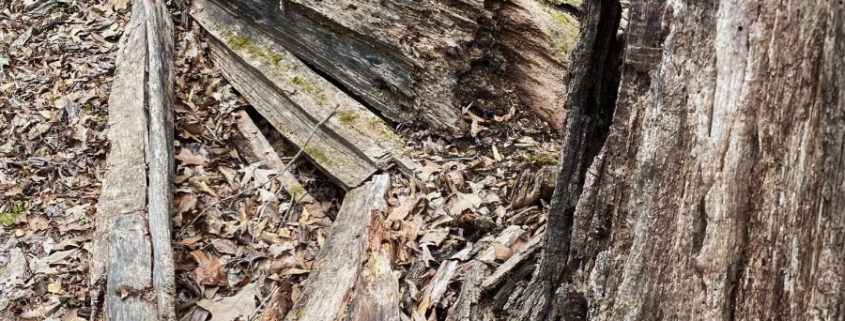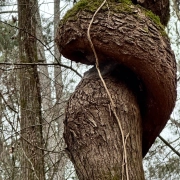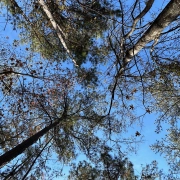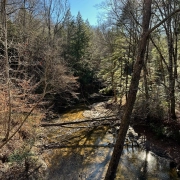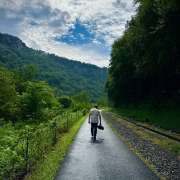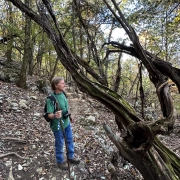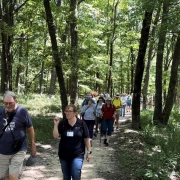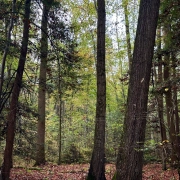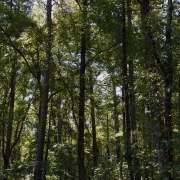What’s Happening in the Old Riparian Hardwood Forests that I Wander (and Wonder): Part One
I have mentally labored on this topic for several years as I’ve repeatedly bushwhacked through the riparian hardwood forests of the Wheeler National Wildlife Refuge, publishing a series of more than two dozen photo essays of my observations, reflections, photographs, and short videos beginning in January 2018. Musing on how these forests will develop 25, 50, and 100 years hence and beyond, I often include photos depicting disturbance. I focus on the changing face of these rich alluvial bottomlands and their majestic forests. I reported three epic oak blowdowns in my June 13, 2023 photo essay chronicling storm damage to big oaks during the winter of 2022-23: https://stevejonesgbh.com/2023/06/13/winter-2022-23-wind-demise-of-multiple-big-oaks-on-the-wheeler-national-wildlife-refuge/
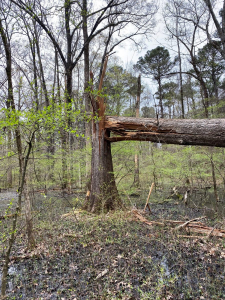
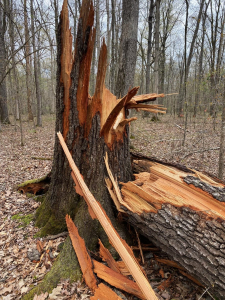
These riparian forest soils are seasonally wet. Strong winds can break these mighty oak trunks, as above, or topple the tree by wrenching roots from their soil grip.
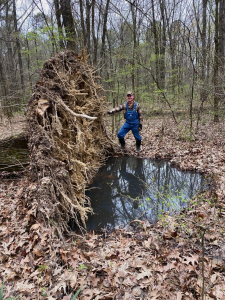
Do these individual tree occurrences signal a major forest renewal shift? I answer simply, “Not yet.” I will present a more complete response in this photo essay.
I published another photo essay on the January 2022, tornado that cut a swath across the northern end of Blackwell Swamp at the Refuge: https://stevejonesgbh.com/2022/05/04/aftermath-of-january-1-2022-tornado-at-wheeler-national-wildlife-refuge/
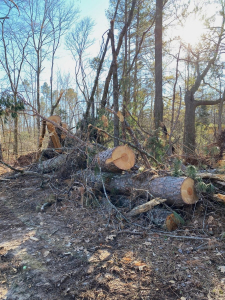
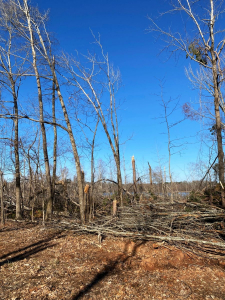
The storm shattered this bur oak that when I photographed it a few weeks after, I thought spelled its certain demise. However, when I returned on July 6, 2024, the tree (center right) showed vigorous regrowth shrouding the splintered trunk.
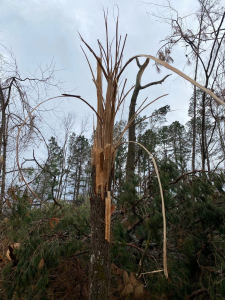
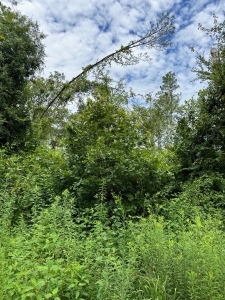
These forests date back to the 1930s when the TVA and Corps of Engineers acquired acreage destined for Wheeler Lake inundation and adjoining buffer lands associated with those properties. The approximate 35,000-acre Refuge’s hardwood forests regenerated naturally; pine forests include hand-planted agricultural fields and natural mixed pine.
The forests have reached an age when forces of Nature are removing scattered large dominant trees like the windthrow at left and the standing large dead (lightning or fungal pathogen killed) tree at right.
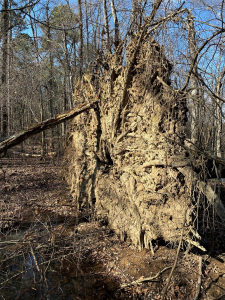
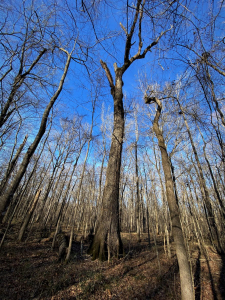
I’m estimating that the dominant (upper crown class) oak below died 2-4 years ago, enough time elapsing that all but its three largest branches have weakened and yielded to gravity. Only a relatively small canopy opening surrounds the deceased crown. Adjoining trees are aggressively closing the gap. The tree’s demise did not bring sustained sunlight to the forest floor, a necessity for encouraging a replacement forest to respond.
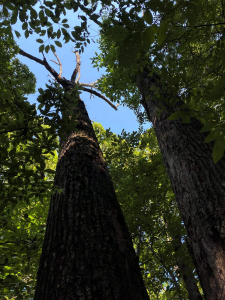
A powerful September 2023 lightning bolt killed this 30-inch diameter red oak. The surrounding trees are already snuffing the temporarily opened canopy (right).
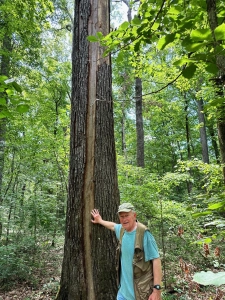
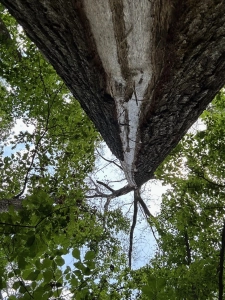
In time, the forest will change, even with the periodic random death of individual and small groups of dominant trees. What will the new forest look like; how will it evolve? I begin this discussion with comments on these two distorted individuals.
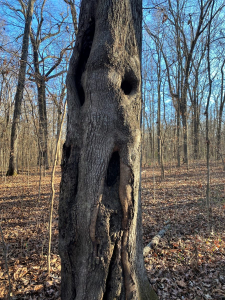
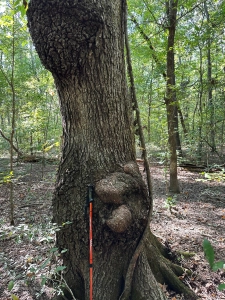
Physical injury earlier in their lives created the disfigurement. Fifty years from now the forest where the tornado touched down will be dense with trees scarred and misshapen by the storm’s fury. I attribute these two tree form oddities to the logging that accompanied acquiring buffer lands along the 1930s soon-to-be lake bed. Loggers cut and transported only merchantable timber (meeting size and market criteria). They left trees too small and of insufficient quality. Many of the nonmerchantable trees suffered physical damage, ensuring that the new forest harbored relics of odd and curious shapes.
This December 21, 2023 photo essay from my September 2023 saunter in the same forest provides more detail: https://stevejonesgbh.com/2023/12/21/an-aging-riparian-hardwood-forest-on-the-wheeler-national-wildlife-refuge/
Pondering the Next Forest
I returned to the forest along HGH Road on Saturday July 6, 2024. A 30-inch white oak demonstrates the fertility and capability of this bottomland site to produce high quality timber.
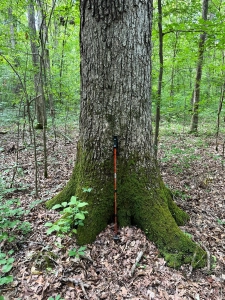
It stands firmly and stoutly, while this neighboring oak yielded to disease agents within the past five years. However, its story is complex. It stood for several years after succumbing, while a brown rot decay fungus consumed its whiter cellulose “carbohydrates, leaving the brownish, oxidized lignin. There is no fibrous texture because the cellulose is broken up early. The wood shrinks on drying and cross-checking is seen in later stages. It is often called cubical brown rot for that reason” (online forest pathology reference). The standing dead tree collapsed within the past several months.
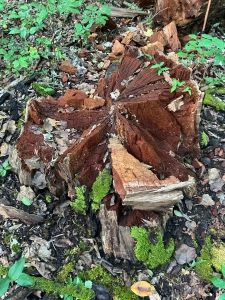
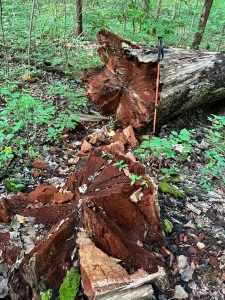
I recorded this 58-second video at the tree’s stump:
The trunk lies where it recently fell, not yet recycling into the forest floor. Five years after the tree died there is still not a surge in understory response from the assumed large canopy opening. The void quickly refilled from the adjoining tree canopy expansion. I have characterized these nearly century-old riparian forests as old growth. However, while they express some features of an old growth forest (large individuals and lots of dead and down woody debris), other criteria are absent: vertically tiered canopy; uneven age; large openings. Old age forests are constantly renewing through attrition and replacement. There is no replacement in these forests.
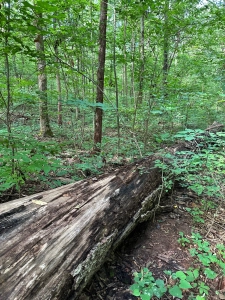
Dominant trees are leaving the stand, usually one tree at a time, creating large canopy voids that quickly refill. The forest is changing, but it is not yet renewing. More radical change (i.e. replacement) will require a higher level of disturbance. This dominant canopy tree toppled within the past three years; its trunk and much of its crown extends one hundred feet beyond.
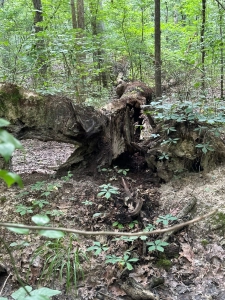
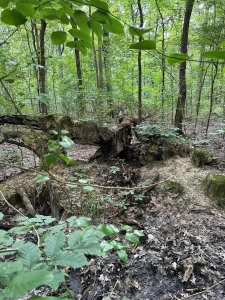
Only an uprooted heavily decayed stump remains in place from this fallen giant. Its remnant pit and mound mark the spot where it stood.
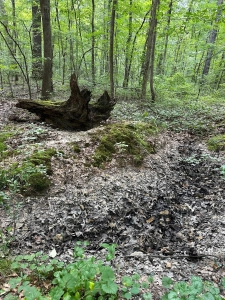
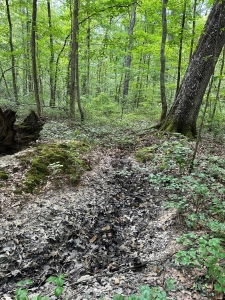
I recorded this 58-second video at the spot.
Winter winds wrenched this oak from its anchorage.
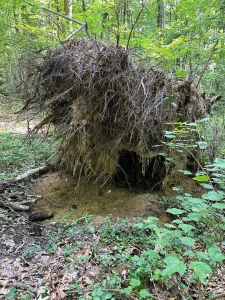
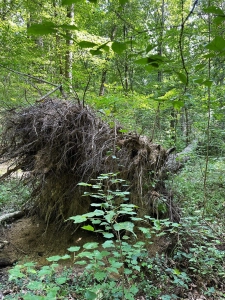
Examples abound of a forest approaching a transition threshold, when renewal (replacement) will initiate.
Tornado Forest Rebirth
Only two miles away, a January 1, 2022, F-0 or F-1 tornado triggered an immediate transition from closed forest to overstory collapse.
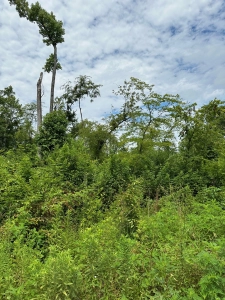
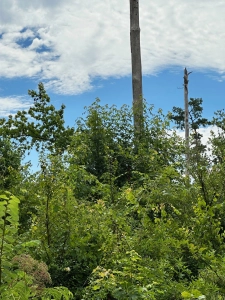
I recorded this 48-second video on my July 2024 visit:
The forest is renewing. Snags are welcoming birds of all manner, including the perching redtail hawk at right.
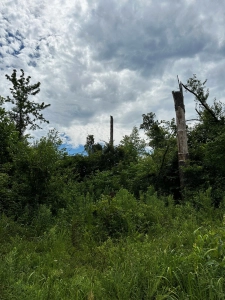
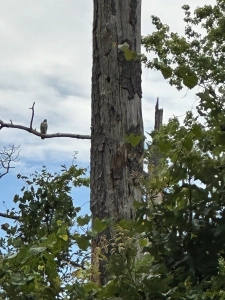
So, the tornado triggered forest renewal. The persistent individual main canopy attrition has not.
I’ll issue Part Two of this tale next week, when I chronicle the woody understory species I photographed July 6, 2024, and offer my tentative look ahead 25, 50, and 100 years hence.
Thoughts and Reflections
I offer these observations:
- Nothing in Nature is static.
- Every tree, every stand, and every forest has a story to tell; I love to read the forested landscape.
- I practice forensic forestry, my retirement craft of interpreting the stories and retelling their tale in simple layman’s language.
- Albert Einstein advised, “Look deep into Nature, and then you will understand everything better.
Inhale and absorb Nature’s elixir. May Nature Inspire, Inform, and Reward you!
Note: Unless otherwise noted, all blog post images are created & photographed by Stephen B. Jones. Please circulate images with photo credit: “©2024 Steve Jones, Great Blue Heron LLC. All Rights Reserved.”
Another Note: If you came to this post via a Facebook posting or by another route, please sign up now (no cost… no obligation) to receive my Blog Post email alerts: http://eepurl.com/cKLJdL
And Third: I am available for Nature-Inspired Speaking, Writing, and Consulting — contact me at steve.jones.0524@gmail.com
A reminder of my Personal and Professional Purpose, Passion, and Cause
If only more of us viewed our precious environment through the filters I employ. If only my mission and vision could be multiplied by untold orders of magnitude:
Mission: Employ writing and speaking to educate, inspire, and enable readers and listeners to understand, appreciate, and enjoy Nature… and accept and practice Earth Stewardship.
Vision:
- People of all ages will pay greater attention to and engage more regularly with Nature… and will accept and practice informed and responsible Earth Stewardship.
- They will see their relationship to our natural world with new eyes… and understand their Earth home more clearly.
Tagline/Motto: Steve (Great Blue Heron) encourages and seeks a better tomorrow through Nature-Inspired Living!
Steve’s Three Books
I wrote my books Nature Based Leadership (2016), Nature-Inspired Learning and Leading (2017), and Weaned Seals and Snowy Summits: Stories of Passion for Place and Everyday Nature (2019; co-authored with Dr. Jennifer Wilhoit) to encourage all citizens to recognize and appreciate that every lesson for living, learning, serving, and leading is either written indelibly in or is powerfully inspired by Nature.
I began writing books and Posts for several reasons:
- I love hiking and exploring Nature
- I see images I want to (and do) capture with my trusty iPhone camera
- I enjoy explaining those images — an educator at heart
- I don’t play golf!
- I do love writing — it’s the hobby I never needed when my career consumed me
- Judy suggested my writing is in large measure my legacy to our two kids, our five grandkids, and all the unborn generations beyond
- And finally, perhaps my books and Blogs could reach beyond family and touch a few other lives… sow some seeds for the future
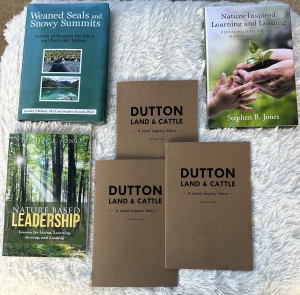

All three of my books (Nature Based Leadership; Nature-Inspired Learning and Leading; Weaned Seals and Snowy Summits) present compilations of personal experiences expressing my (and co-author Dr. Wilhoit for Weaned Seals and Snowy Summits) deep passion for Nature. All three books offer observations and reflections on my relationship with the natural world… and the broader implications for society. Order any from your local indie bookstore, or find them on IndieBound or other online sources such as Amazon and LifeRich.
I now have a fourth book, published by Dutton Land and Cattle Company, Dutton Land & Cattle: A Land Legacy Story.

